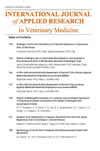菟丝子体外细胞毒性及遗传毒性筛选。Achillea wilhelmsii C. Koch为进一步的药物设计进行临床前分析
4区 农林科学
Q4 Veterinary
International Journal of Applied Research in Veterinary Medicine
Pub Date : 2022-12-24
DOI:10.30782/jrvm.1161358
引用次数: 0
摘要
植物基化合物自古以来就被用于医疗目的,作为易于获得和低成本的治疗选择。尽管人们普遍认为植物是非常安全的,没有副作用,但科学研究表明,植物的活性成分对健康细胞有潜在的毒性。本研究旨在探讨阿喀琉叶(Achillea wilhelmsii C. Koch)和秋葵(Cuscuta arvensis Beyr)的体外细胞毒性和遗传毒性潜力。这是传统医学中经常使用的。在这种情况下,采用MTT(3-[4,5-二甲基噻唑-2-基]-2,5-二苯基溴化四唑)测定法对提取物进行细胞毒性评价。我们的细胞毒性结果表明,在任何浓度下,黄颡鱼提取物都不影响成纤维细胞的活力,但在浓度为25µg/mL时,反而显著刺激细胞增殖。另一方面,在所有浓度的测试中,红草提取物都显著降低了成纤维细胞的活力。在本研究的第二部分,通过体外彗星试验研究了非细胞毒性浓度下提取物的DNA损伤潜力。只有在最高浓度下,黄颡鱼提取物才会显著增加尾DNA百分比(%TDNA),这被认为是DNA损伤的一个指标,而黄颡鱼提取物在不同浓度下对%TDNA没有显著影响。本研究结果表明,在100 μg/mL的浓度下,黄菖蒲醇提物是安全的,但黄菖蒲的细胞毒性可能是限制其安全使用的一个因素。本文章由计算机程序翻译,如有差异,请以英文原文为准。
In vitro cytotoxicity and genotoxicity screening of Cuscuta arvensis Beyr. and Achillea wilhelmsii C. Koch in preclinical analysis for further drug design
Plant-based compounds have been used for medicinal purposes since ancient times, as easily accessible and low-cost treatment options. Despite the widespread belief that plants are quite safe and devoid of side effects, scientific studies have revealed the toxicity potential of active components of plants on healthy cells. The present study was designed to investigate in vitro cytotoxicity and genotoxicity potential of Achillea wilhelmsii C. Koch and Cuscuta arvensis Beyr., which are frequently used in traditional medicine. In this context, cytotoxicity evaluation of the extracts was performed by MTT (3- [4,5-dimethylthiazol-2-yl]-2,5-diphenyl tetrazolium bromide) assay. Our cytotoxicity results indicated that the extract from A. wilhelmsii did not affect the viability of fibroblasts at any of the concentrations, but rather significantly stimulated cell proliferation from a concentration of 25 µg/mL. On the other hand, the extract from C. arvensis significantly reduced the viability of fibroblasts at all concentrations tested. In the second part of this research, the DNA damaging potential of the extracts was investigated by in vitro comet assay at non-cytotoxic concentrations. A. wilhelmsii extract caused a significant increase in the percentage of DNA in the tail (%TDNA), which is considered an indicator of DNA damage, only at the highest concentration, while C. arvensis extract did not significantly affect %TDNA at concentrations tested. The results of the present study indicated that the methanolic extract from A. wilhelmsii may be considered safe up to a concentration of 100 μg/mL, however, the cytotoxicity potential of C. arvensis may be a factor limiting its safe use.
求助全文
通过发布文献求助,成功后即可免费获取论文全文。
去求助
来源期刊
自引率
0.00%
发文量
1
审稿时长
3 months
期刊介绍:
The International Journal of Applied Research in Veterinary Medicine promotes excellence in the clinical practice of veterinary medicine by disseminating fundamental scientific, diagnostic, and treatment knowledge gained from prospective and retrospective research in a timely manner. The Journal fulfills its mission through rapid peer review of each submitted article, and publication of all articles within 90 days of acceptance. All published articles meet the standards of Balance, Independence, Objectivity and Scientific Rigor.

 求助内容:
求助内容: 应助结果提醒方式:
应助结果提醒方式:


